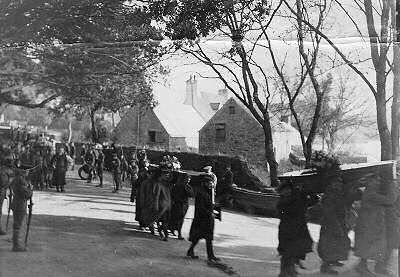|
|
The Channel Islands and the Great War
|
|
Jersey and
its German Prisoners of War
|
Not Everyone Went Home!
The US Embassy's Report of 1916 stated
that:
"This Camp seemed almost to be a model of its
kind, and the men appeared to be in extraordinary good
physical condition"
However, during the time that the Camp
contained German Prisoners of War, seven of them died.
These included:
-
A sailor, Karl Brundig aged 21, a
surviving crew member from the cruiser "Mainz"
sunk at the Battle of Heligoland in 1914. It appears
that the cause of his death was epilepsy and syncope,
and he was buried at St. Peter's Parish Churchyard,
the only one of the seven to be.
-
A soldier, Konrad Flechsig from the
243rd Infantry Regiment who died on 12th May 1916
and was buried the following day at St. Brelade's
Parish Churchyard.
|
|
The remains of the Germans rested where they had been
laid, along with those of more than 200 of their fellow
countrymen who died in the Second World War. The original
crosses for the Great War deaths were, it is believed,
made from old oak and were similar in shape to the Iron
Cross, however these were replaced during the Second World
War with an Iron Cross design with the swastika set in
the middle of the cross.
After the war, the swastikas were removed from the cross,
and possibly later in 1955 simple white crosses were introduced.
During 1961 a mass exhumation took place of the remains
of many of the German war dead of both World Wars throughout
the Channel Islands and these were transferred to the
German Ossuary near Huisnes-sur-Mer in northern France.
|

The Funeral of Three German Soldiers at St Brelade's
Church
|
|
The Camp Guards
At the present time it remains unclear as
to which British unit(s) provided the camp guards, although
it is suspected that this was undertaken by 351st Company,
Royal Defence Corps, for which recruiting advertisements
were placed in Jersey's Evening Post at odd times during
the war, seeking to enlist men aged between 41 and 55
years.
Further Help
This article is the subject of continuing research and
development, and any additional information and factual
corrections will be greatly appreciated.
|
 Page 3
Page 3 |
© Barrie Bertram 2006
|
|